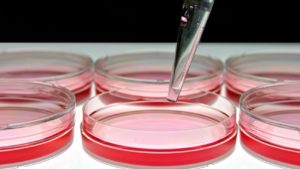Choosing and Optimizing Transfection Methods

Here in Technical Services we often talk with researchers at the beginning of their project about how to carefully design and get started with their experiments. It is exciting when you have selected the Luciferase Reporter Vector(s) that will best suit your needs; you are going to make luminescent cells! But, how do you pick the best way to get the vector into your cells to express the reporter? What transfection reagent/method will work best for your cell type and experiment? Do you want to do transient (short-term) transfections, or are you going to establish a stable cell line?
Successful reagent-based transfection involves optimizing the reagent:DNA ratio, amount of DNA used, complexing time, cell number and medium used. It is important to use a low passage number and ensure healthy cells are ~40-80% confluent on the day of transfection. The Promega vectors are provided at transfection-ready quality, so you can start right away. However, if you propagate the vector by transforming bacteria, the plasmid should be purified so that it is intact and free of protein, RNA and endotoxin. Be aware, any of the Promega Flexi® Vectors that contain a lethal barnase gene cannot be propagated until after cloning, when this portion is replaced. This article can help you decide “What transfection reagent should I choose?” among the reagents that Promega offers with some common cell types. If you don’t see your cell type in the list, you can search the literature to see what reagents other researchers have used with success. If a transfection reagent has never been tested with your cell type, Promega occasionally offers free samples, so reach out to your local sales person, or contact Technical Services to connect you with them. Once you have decided on a transfection reagent, here is a great article with details about how to quickly “Optimize Transfection of Cultured Cells”. Promega also offers the FuGENE® HD Protocol Database and Transfection Assistant tools, collections of protocols that guide the transfection process for a variety of cell lines including ratios and volumes for different plates.
When you have optimized the transfection of your cells, you can move forward with transient transfection experiments or establish a stable cell line. The goal of stable, long-term transfection is to isolate and propagate individual clones containing transfected vector that has integrated into the cellular genome. Screening for clones can be accomplished by drug selection when an appropriate drug-resistance marker is included in the transfected vector. Before using a drug for selection purposes, you will need to determine the amount of drug necessary to kill untransfected cells, sometimes called a kill curve. When drug selection is used, cells are maintained in standard medium for 1–2 days after transfection, then cells are replated in selective medium containing the drug, with frequent changes to eliminate dead cells and debris. When cells have grown back to confluency, individual cells can be obtained by limiting dilution or blind sorting live single cells into 96-well plates and incubating for 2-3 weeks in selective medium for single colonies to form. For a protocol to select transfected cells by antibiotics, see this Stable Transfection example.
After you have transient or stably transfected cells, you are ready to see them glow! Be sure that you use a Reporter Assay detection reagent with the substrate specific for your type of luciferase reporter(s). The firefly, Renilla and NanoLuc® luciferase reactions utilize their respective substrates beetle luciferin, coelenterazine and furimazine to yield light. Many plate readers will have a standard luminescence setting, but with some bright samples, like when using NanoLuc®, you can detect the signal with your phone camera ! As always, please contact Technical Services if you have any questions along the way.
More Resources on Transfection
This Transfection Protocols and Applications Guide has tons of useful information to help you decide which route you want to take, and what reagents/methods are available to choose. Promega does not yet offer vectors ready for viral transduction, but there are viral expression vectors available through the Addgene repository which utilize luciferase reporters.
Related Posts
Latest posts by Joliene Lindholm (see all)
- A Day in the Life of a Technical Services Scientist - May 24, 2021
- Oh, The Ways You Can “Glo” - February 22, 2021
- Designing a Reporter Construct for Analyzing Gene Regulation - December 10, 2019
